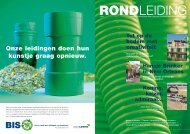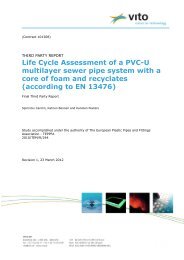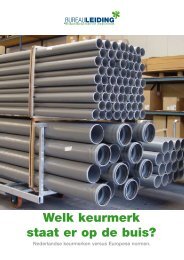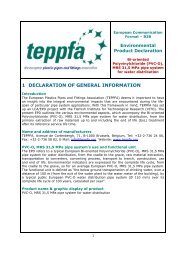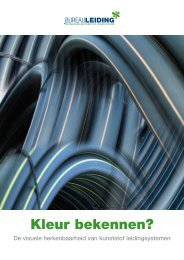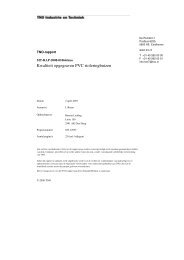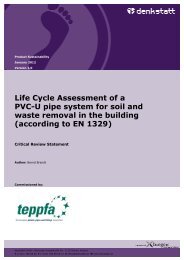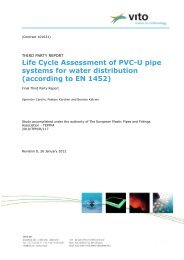Life Cycle Assessment of a PE pipe system for ... - BureauLeiding
Life Cycle Assessment of a PE pipe system for ... - BureauLeiding
Life Cycle Assessment of a PE pipe system for ... - BureauLeiding
You also want an ePaper? Increase the reach of your titles
YUMPU automatically turns print PDFs into web optimized ePapers that Google loves.
Table <strong>of</strong> ContentsTABLE OF CONTENTSTable <strong>of</strong> Contents ___________________________________________________________________IChapter 1 Introduction _____________________________________________________________ 1Chapter 2 Goal and scope definition _______________________________________________ 32.1 Definition <strong>of</strong> goal <strong>of</strong> the study _____________________________________ 32.2 Definition <strong>of</strong> scope <strong>of</strong> the study ____________________________________ 3Chapter 3 <strong>Life</strong> cycle inventory _____________________________________________________ 73.1 Data requirements ______________________________________________ 73.2 Data collection procedures ________________________________________ 8Chapter 4 <strong>Life</strong> cycle impact assessment ___________________________________________ 94.1 Method _______________________________________________________ 94.2 The environmental pr<strong>of</strong>ile <strong>of</strong> the <strong>PE</strong> <strong>pipe</strong> <strong>system</strong> <strong>for</strong> water distribution _____ 10Chapter 5 Final conclusions _______________________________________________________ 13Chapter 6 Critical review statement ______________________________________________ 156.1 Introduction _________________________________________________ 156.2 Review Process ______________________________________________ 156.3 Scientific Background _________________________________________ 166.4 Critical Review Findings _______________________________________ 166.5 Conclusion __________________________________________________ 17List <strong>of</strong> references __________________________________________________________________ 19I
Chapter 1 Introductionconstruction works” are used (CEN TC 350 draft framework documents, 2008 – 2009).An overview <strong>of</strong> these categories can be found in the clean version <strong>of</strong> the prEN15804(Sustainability <strong>of</strong> construction works – Environmental Product Declarations – Core rules<strong>for</strong> the product category <strong>of</strong> construction products).The design <strong>of</strong> this report complies with these 4 phases <strong>of</strong> the LCA, whereby the variouschapters describe each phase <strong>of</strong> the LCA. All relevant ISO guidelines were implementedwhen compiling this ‘Third Party Report’ (ISO 14044, paragraph 5.2).2
Chapter 2 Goal and scope definitionCHAPTER 2GOAL AND SCO<strong>PE</strong> DEFINITION2.1 Definition <strong>of</strong> goal <strong>of</strong> the studyTEPPFA wants a cradle to grave LCA consistent with ISO 14040 and ISO 14044 series <strong>of</strong>standards to assess the environmental per<strong>for</strong>mance <strong>of</strong> TEPPFA plastic piping <strong>system</strong>s.This LCA-study aims to examine the <strong>PE</strong> <strong>pipe</strong> <strong>system</strong> <strong>for</strong> water distribution (utilities), togather and assess comprehensive and reliable in<strong>for</strong>mation regarding the environmentalper<strong>for</strong>mance <strong>of</strong> this <strong>PE</strong> <strong>pipe</strong> <strong>system</strong>, generated over its entire life cycle. In the sametime, this study helps to provide a reliable database <strong>for</strong> the development <strong>of</strong> an ISO14025 Type III Environmental Product Declarations (EPDs) on the European level <strong>for</strong>the <strong>PE</strong> <strong>pipe</strong> <strong>system</strong> <strong>for</strong> water distribution (utilities). The CEN framework (TC 350 –Sustainability <strong>of</strong> construction works) and more specifically the work per<strong>for</strong>med withinthe technical committee TC 350 (CEN TC 350 framework documents, 2008-2009) isused <strong>for</strong> this project.The intended audience <strong>of</strong> the LCA-study <strong>of</strong> the <strong>PE</strong> <strong>pipe</strong> <strong>system</strong> <strong>for</strong> water distribution(utilities) is the TEPPFA member companies and its National Assciations in the firstplace and external stakeholders (like governments, pr<strong>of</strong>essionals, contractors) at thesecond stage. For the latter, TEPPFA expects to use the in<strong>for</strong>mation from this study inaggregated manner <strong>for</strong> public communications, to develop marketing materials <strong>for</strong>customers and to provide data to customers <strong>for</strong> the purpose <strong>of</strong> developing LCIs andEPDs within the building and construction sector.Since TEPPFA wishes to publicly communicate the results <strong>of</strong> the LCAs a critical reviewand 3 rd party report are per<strong>for</strong>med. This critical review is per<strong>for</strong>med by Denkstatt.2.2 Definition <strong>of</strong> scope <strong>of</strong> the studyThe scope <strong>of</strong> the study is defined in the functional unit. The functional unit is closelyrelated to the function(s) fulfilled by the to-be-investigated product. The function <strong>of</strong> the<strong>PE</strong> <strong>pipe</strong> <strong>system</strong> <strong>for</strong> water distribution is to transport (supply) a certain amount <strong>of</strong> waterfrom the exit <strong>of</strong> the water plant to the water meter <strong>of</strong> the building. In consultation withTEPPFA, its steering committee and the Application Group (AG) Utilities the definition <strong>of</strong>the function and the functional unit <strong>of</strong> the <strong>PE</strong> <strong>pipe</strong> <strong>system</strong> was discussed. The basicassumption was that the definition <strong>of</strong> the functional unit should represent the function<strong>of</strong> the <strong>PE</strong> <strong>pipe</strong> <strong>system</strong> over its entire life cycle: raw material extraction, materialproduction, production <strong>of</strong> the <strong>pipe</strong>s and fittings, the construction phase, the use phaseand the processing <strong>of</strong> the waste at the end <strong>of</strong> life <strong>of</strong> the <strong>PE</strong> <strong>pipe</strong>s and fittings. Thefunctional unit <strong>of</strong> the <strong>PE</strong> <strong>pipe</strong> <strong>system</strong> has been defined as: “the below groundtransportation <strong>of</strong> drinking water, over a distance <strong>of</strong> 100 m (from the exit <strong>of</strong> the waterplant to the water meter <strong>of</strong> the building), by a typical public European <strong>PE</strong> <strong>pipe</strong> waterdistribution <strong>system</strong> (Ø 110mm) over its complete life cycle <strong>of</strong> 100 years, calculated peryear”.3
Chapter 2 Goal and scope definitionIn order to define the design <strong>of</strong> the <strong>PE</strong> <strong>pipe</strong> <strong>system</strong> in terms <strong>of</strong> the functional unit thefollowing considerations have been made:• The complete <strong>PE</strong> <strong>pipe</strong> <strong>system</strong> <strong>for</strong> water distribution is considered;• The <strong>pipe</strong> material consists <strong>of</strong> black polyethylene MRS (minimum requiredstrengths) 10 MPa (<strong>PE</strong> 100) with blue stripes (in accordance with EN 12201);• The <strong>pipe</strong> has a diameter: ø 110 mm (as a representative <strong>for</strong> the typical <strong>pipe</strong>diameter from the exit <strong>of</strong> the water plant to the water meter <strong>of</strong> the building) and awall thickness <strong>of</strong> 6,6 mm;• Standard dimension ratio is SDR 17;• The 110 mm <strong>pipe</strong>s are calculated as average weight per metre calculated fromactual sales across a market in sizes 20 mm to 1000 mm;• Two types <strong>of</strong> fittings are considered in the LCA: electr<strong>of</strong>usion and buttwelding. Thepopularity <strong>of</strong> fittings in “average” <strong>pipe</strong> <strong>of</strong> functional unit has been calculated fromactual sales data. The average ratio by weight <strong>of</strong> fittings to <strong>pipe</strong> is approximately10% (calculated from an actual water supply contract);• Flow capacity <strong>of</strong> a 110 mm SDR 17, <strong>PE</strong>100 <strong>pipe</strong> <strong>of</strong> average roughness at 1,5 m persecond (EN 805 advises that “in practice it will be desirable to avoid unduly high orlow velocities. The range 0,5 m/s to 2,0 m/s may be considered appropriate);• Most common components used in functional unit (accounting <strong>for</strong> 80% <strong>of</strong> totalweight): tapping Tee, coupler, flange (inc. nuts, bolts, washes and gaskets), 45elbow, 90 elbow;• The reference service life time <strong>of</strong> the <strong>PE</strong> <strong>pipe</strong> <strong>system</strong> is considered to be 100 year(Source: Ulrich Schulte and Joachim Hessel, 2006).The life cycle <strong>of</strong> the <strong>PE</strong> <strong>pipe</strong> <strong>system</strong> <strong>for</strong> water distribution has been divided in thefollowing different life cycle phases:• Production <strong>of</strong> raw materials <strong>for</strong> <strong>PE</strong> <strong>pipe</strong>s;• Transport <strong>of</strong> <strong>PE</strong> <strong>pipe</strong> raw materials to converter;• Converting process <strong>for</strong> <strong>PE</strong> <strong>pipe</strong>s (extrusion);• Production raw materials <strong>for</strong> <strong>PE</strong> fittings;• Transport <strong>of</strong> <strong>PE</strong> fitting raw materials to converter;• Converting process <strong>for</strong> <strong>PE</strong> fittings (injection moulding);• Production <strong>of</strong> galvanised steel components (raw materials + converting process);• Production <strong>of</strong> EPDM gaskets (raw materials + converting process);• Transport <strong>of</strong> complete <strong>PE</strong> <strong>pipe</strong> <strong>system</strong> to the trench;• Installation <strong>of</strong> complete <strong>PE</strong> <strong>pipe</strong> <strong>system</strong> in the trench;• Use <strong>of</strong> the complete <strong>PE</strong> <strong>pipe</strong> <strong>system</strong> during 100 years <strong>of</strong> reference service life time;• Maintenance <strong>of</strong> the complete <strong>PE</strong> <strong>pipe</strong> <strong>system</strong> during 100 years <strong>of</strong> reference servicelife time;• Transport <strong>of</strong> complete <strong>PE</strong> <strong>pipe</strong> <strong>system</strong> after 100 years <strong>of</strong> reference service life time;• End-<strong>of</strong>-life waste treatment <strong>of</strong> complete <strong>PE</strong> <strong>pipe</strong> <strong>system</strong> after 100 years <strong>of</strong>reference service life time.4
Chapter 2 Goal and scope definitionThe following underlying principles are adopted when <strong>system</strong> boundaries areestablished:• The infrastructure (production <strong>of</strong> capital goods like buildings, equipment) is notconsidered in this study <strong>for</strong> what concerns the converting plants <strong>of</strong> the <strong>PE</strong> <strong>pipe</strong>s andfittings. For all other processes (production <strong>of</strong> basic materials, additives, energy,transport, etc.) the impact <strong>of</strong> capital goods is included in the analysis. For examplethe impact <strong>of</strong> the <strong>pipe</strong>lines <strong>for</strong> natural gas are considered, as well as the impact <strong>of</strong>the production <strong>of</strong> transport modes (e.g. trucks) and transport infrastructure (e.g.roads).• Accidental pollution is not considered in this LCA;• Environmental impacts which are caused by the personnel <strong>of</strong> production units aredisregarded. This, <strong>for</strong> example, concerns waste originating from canteens andsanitary installations. Environmental measures relating to waste processingprocesses (combustion kilns, <strong>for</strong> example) are taken into consideration in the LCAstudy. Greater focus is placed on the final processing, and thus the end destination<strong>of</strong> generated waste flows.• To model different waste treatment processes during the LCA-project we used theend <strong>of</strong> life (EoL) approach <strong>for</strong> incineration and landfill; and the recycled contentapproach <strong>for</strong> recycling:• For incineration and landfill this means that the impacts (as well as thebenefits: <strong>for</strong> example the energy recovery during waste incineration) <strong>of</strong> theamount <strong>of</strong> waste that is treated by waste treatment facilities, is assigned tothe producing process (this means the process that causes the waste, so the<strong>PE</strong> <strong>pipe</strong> <strong>system</strong> <strong>for</strong> water distribution LCA). Waste that is incinerated withenergy recovery is considered as part <strong>of</strong> the <strong>system</strong> under study. This meansthat emissions and energy consumption related to waste treatment areincluded in the LCA. For waste incineration the avoided electricity productiondue to energy recovery <strong>of</strong> waste incineration is taken into account.• For waste recycling the credits <strong>of</strong> recyclates (secondary raw materials that canbe used as input materials, so less virgin raw materials needed) areconsidered as soon as they are actually used (assigned to the product lifecycle that uses the recyclates). This means that transport to the recyclingplant is included. The recycling process itself and that fact that fewer rawmaterials are needed when the produced recyclates (product <strong>of</strong> the recyclingprocess) are used as secondary raw materials are allocated to the life cyclewhere the recyclates are used.Only <strong>for</strong> some processes there was a need to use so-called ‘cut-<strong>of</strong>f’ rule where the inputon mass basis is lower than 1%:• Transportation <strong>of</strong> the different packaging waste flows to the respective treatmentfacilities;• The production <strong>of</strong> the packaging materials to pack the raw materials <strong>for</strong> <strong>PE</strong> <strong>pipe</strong>sand <strong>PE</strong> fittings in order to be able to easily transport them from the producers tothe converters.For the TEPPFA project VITO uses the different environmental impact categoriespresented in the draft documents prepared by Technical Committee CEN/TC 350(Sustainability <strong>of</strong> construction works – Environmental Product Declarations – Core rules<strong>for</strong> the product category <strong>of</strong> construction products – presented in the draft prEN15804(CEN TC 350 framework documents, 2008-2009).The results <strong>of</strong> an LCA depend on different factors. Sensitivity analyses assess theinfluence <strong>of</strong> the most relevant and most uncertain factors on the results <strong>of</strong> the study.The results <strong>of</strong> these sensitivity analyses are compared to the basic scenarios.Sensitivity analyses don’t make the basic data <strong>of</strong> a study more reliable, but allow to5
Chapter 2 Goal and scope definitionassess the effect <strong>of</strong> a change in inventory data on the results and conclusions <strong>of</strong> thestudy.For this project we decided not to put a lot <strong>of</strong> ef<strong>for</strong>t in sensitivity analyses, since itappears from the life cycle impact assessment <strong>of</strong> the <strong>PE</strong> <strong>pipe</strong> <strong>system</strong> <strong>for</strong> ultilityapplications that the data and the uncertainty on the data <strong>for</strong> the most important lifecycle phases (raw materials <strong>for</strong> <strong>PE</strong> <strong>pipe</strong>s and transportation <strong>of</strong> these raw materials toconverters) are thoroughly discussed during the workshops. These data are based onEuropean averages established through PlasticsEurope (<strong>PE</strong> raw materials <strong>for</strong> <strong>pipe</strong>s -mainly caused by the <strong>PE</strong> resin production) or based on company-specific knowledge onthe way the raw materials are transported to the TEPPFA member companies (averages<strong>of</strong> different individual datasets from different TEPPFA member companies). To put a lot<strong>of</strong> ef<strong>for</strong>ts into sensitivity analyses on other life cycle phases having a less importantcontribution to the overall environmental pr<strong>of</strong>ile was not efficient to our opinion. Forthis project additional sensitivity analyses will not have much added value.6
Chapter 3 <strong>Life</strong> cycle inventoryCHAPTER 3LIFE CYCLE INVENTORY3.1 Data requirementsThe objective is to compose a dataset that is representative and relevant <strong>for</strong> a typicalEuropean <strong>PE</strong> <strong>pipe</strong> <strong>system</strong> <strong>for</strong> utility applications. The data that are used in this LCAstudy are not case-specific, but reflect the average European representative situation.The production processes run according to European standardised norms andequipment and thus they are very similar across Europe. Since the LCA study on the <strong>PE</strong><strong>pipe</strong> <strong>system</strong> is per<strong>for</strong>med <strong>for</strong> an anticipated European average, European manufacturerdata are used. The TEPPFA member companies represent more than 50% <strong>of</strong> theEuropean market <strong>for</strong> extruded plastic <strong>pipe</strong>s.All data relates to the existing situation in Europe, using existing production techniques.Data are as much as possible representative <strong>for</strong> the modern state-<strong>of</strong>-technology. Assuch Europe in the period 2000-2008 is considered as the geographical and timecoverage <strong>for</strong> these data.The used data are consistently reported and critically reviewed, so that they can beeasily reproduced. If in this document is referred to “a <strong>pipe</strong> <strong>system</strong>”, this means the<strong>pipe</strong> <strong>system</strong> representing the average at the European level, and not one specific <strong>pipe</strong><strong>system</strong>. Calculations <strong>of</strong> the amounts <strong>of</strong> <strong>PE</strong> <strong>pipe</strong>s, <strong>PE</strong> fittings, galvanised steel andstainless steel components and ethylene propylene dipolymer (EPDM) gaskets (neededper 100 m <strong>of</strong> an average European <strong>pipe</strong> <strong>system</strong> <strong>for</strong> water distribution) are based on aconsensus within the AG Utilities. They are based and calculated on the 100 m <strong>of</strong> <strong>pipe</strong><strong>system</strong> (see Table 1).Table 1: <strong>PE</strong> <strong>pipe</strong> <strong>system</strong> <strong>for</strong> water distribution (utilities) in relation to the functional unit<strong>PE</strong> <strong>pipe</strong> <strong>system</strong>Average inkg/100 m -life time 100 yrAverage inkg/FU -excl. <strong>pipe</strong> leftover)Average inkg/FU -incl. <strong>pipe</strong> leftoverAverage <strong>PE</strong><strong>pipe</strong> leftover duringinstallation(2%)(kg/FU)<strong>PE</strong> <strong>pipe</strong> 217 2,17 2,2134 0,0434<strong>PE</strong> fittings 15,84 0,1584Bolts, ring, washers, nuts(galvanised steel)19,5 0,195Alloy 0,15 0,0015Steel cutter 0,88 0,0088EPDM gaskets 0,2 0,002 10007
Chapter 3 <strong>Life</strong> cycle inventoryFor each life cycle phase an overview is generated <strong>of</strong> all environmental flows whichconcern the functional unit:Data on the raw materials <strong>for</strong> <strong>PE</strong> <strong>pipe</strong>s and fittings are coming fromPlasticsEurope (the association <strong>of</strong> plastics manufacturers) and the <strong>PE</strong>100+ association.PlasticsEurope represent the European plastics manufacturing chain.Data on extrusion and injection moulding processes are collected within theframework <strong>of</strong> a project that has been carried out by TNO in commission <strong>of</strong>PlasticsEurope. In this framework TNO collected the environmental inputs and outputsrelated to the extrusion <strong>of</strong> <strong>PE</strong> <strong>pipe</strong>s and injection moulding <strong>of</strong> <strong>PE</strong> fittings. The TEPPFAand VITO experts critically reviewed the proposed datasets <strong>for</strong> the two convertingprocesses and <strong>for</strong>mulated questions and remarks to TNO. Then TEPPFA and VITOexperts prepared a revised version <strong>for</strong> European average datasets <strong>for</strong> <strong>PE</strong> fittingsinjection moulding and <strong>PE</strong> <strong>pipe</strong> extrusion. The revised datasets have been used withinthis LCA study. The datasets also included transport <strong>of</strong> raw materials to converters andpackaging <strong>of</strong> produced products (<strong>pipe</strong>s and fittings).Data on other <strong>pipe</strong> <strong>system</strong> components are coming from the TEPPFA experts(amounts that are needed <strong>for</strong> the functional unit) and from publicly available LCAdatabases (LCI data per kg <strong>of</strong> component that is part <strong>of</strong> the <strong>PE</strong> <strong>pipe</strong> <strong>system</strong>).Application specific data are dealing with all life cycle phases from the transportation<strong>of</strong> the packed <strong>PE</strong> <strong>pipe</strong> <strong>system</strong> to the customer to the final EoL treatment scenario. Inthis framework VITO prepared an application-specific questionnaire in closeconsultation with the TEPPFA experts. The collection <strong>of</strong> application specific dataencompasses the identification <strong>of</strong> different kind <strong>of</strong> scenarios <strong>for</strong> transport toconstruction site, construction process and demolition process and the EoL treatment.3.2 Data collection proceduresWherever possible, data collection is based on data derived from members <strong>of</strong> TEPPFA,TEPPFA experts, representative organisations <strong>for</strong> the raw material producers, dataderived from suppliers and data from public LCA databases. TEPPFA supplied, withlogistical support from VITO, all environment-related data <strong>for</strong> processes which takeplace within the converting factories and during the application itself (transport totrench, installation, demolition after 100 years <strong>of</strong> service life time, transport to EoLtreatment, and EoL treatment itself). The data collection process was discussed duringseveral workshops with the TEPPFA member companies.Summarised, the data inventory collection process appealed to:• inquiries (based on specific questionnaires) <strong>of</strong> relevant actors being therepresentative organisations <strong>of</strong> the raw material producers, the different membercompanies <strong>of</strong> TEPPFA and their suppliers;• simultaneously literature sources that discuss similar issues are consulted;• if needed, specific data supplied by the TEPPFA member companies and relevant<strong>for</strong> Europe are used;• <strong>for</strong> the background processes, generic data from literature and publicly availabledatabases are used (more general data, representative <strong>for</strong> Europe);• <strong>for</strong> aspects where no specific or literature data are found an assumption is made,based on well-founded arguments.8
Chapter 4 <strong>Life</strong> cycle impact assessmentCHAPTER 4LIFE CYCLE IMPACT ASSESSMENT4.1 MethodDuring impact assessment, the emission- and consumption-data <strong>of</strong> the inventory phaseare aggregated into environmental impact categories. The use <strong>of</strong> raw materials, energyconsumption, emissions and waste are converted into a contribution to environmentalimpact categories. The result <strong>of</strong> the impact assessment is a figure or table in which theenvironmental themes (environmental impact categories) are presented, describing theenvironmental pr<strong>of</strong>ile <strong>of</strong> the selected functional unit “the below ground transportation <strong>of</strong>drinking water, over a distance <strong>of</strong> 100 m (from the exit <strong>of</strong> the water plant to the watermeter <strong>of</strong> the building), by a typical public European <strong>PE</strong> <strong>pipe</strong> water distribution <strong>system</strong>(Ø 110mm) over its complete life cycle <strong>of</strong> 100 years, calculated per year”.For this project VITO uses the different life cycle impact categories presented in thedraft documents prepared by Technical Committee CEN/TC 350 “Sustainability <strong>of</strong>construction works (CEN TC 350 draft framework documents, 2008 - 2009):• Abiotic depletion;• Acidification;• Eutrophication;• Global warming;• Ozone layer depletion;• Photochemical oxidation.The optional declaration on ionising radiation is not being considered in this study. AnLCA calculates the potential contribution <strong>of</strong> the <strong>pipe</strong> <strong>system</strong>s life cycle to the differentenvironmental impact categories. Radiation <strong>of</strong>ten relates to electricity consumption, butmeanwhile we know that the contribution <strong>of</strong> electricity production to radiation isnegligible. For this reason we do not consider radiation as an environmental impactcategory in this LCA study.For per<strong>for</strong>ming the life cycle impact assessment (LCIA) VITO uses the LCA s<strong>of</strong>twarepackage “SimaPro 7.3.0” <strong>for</strong> per<strong>for</strong>ming the life cycle impact assessment (LCIA) andgenerating the environmental pr<strong>of</strong>ile <strong>of</strong> the <strong>PE</strong> <strong>pipe</strong> <strong>system</strong> <strong>for</strong> water distribution.In discussing the results <strong>of</strong> the individual pr<strong>of</strong>ile <strong>of</strong> the <strong>PE</strong> <strong>pipe</strong> <strong>system</strong> <strong>for</strong> waterdistribution it is important to know whether or not a process has a significantcontribution to an environmental impact category. For that the ISO framework (ISO14044 - Annex B) is used. According to the ISO 14044 Annex B the importance <strong>of</strong>contributions can classified in terms <strong>of</strong> percentage. The ranking criteria are:A: contribution > 50 %: most important, significant influence;B: 25 % < contribution ≤ 50 %: very important, relevant influence;C: 10 % < contribution ≤ 25 %: fairly important, some influence;D: 2,5 % < contribution ≤ 10 %: little important, minor influence;E: contribution < 2,5 %: not important, negligible influence.9
Chapter 4 <strong>Life</strong> cycle impact assessment4.2 The environmental pr<strong>of</strong>ile <strong>of</strong> the <strong>PE</strong> <strong>pipe</strong> <strong>system</strong> <strong>for</strong> waterdistributionThe environmental pr<strong>of</strong>ile shows the contribution <strong>of</strong> the various steps in the life cycleper environmental impact category. For each environmental impact category, the totalcontribution <strong>of</strong> the <strong>PE</strong> <strong>pipe</strong> <strong>system</strong> is always set at 100% and the relative contributions<strong>of</strong> the various subprocesses are visible.Table 2 and Figure 1 present the environmental pr<strong>of</strong>ile <strong>for</strong> the <strong>PE</strong> <strong>pipe</strong> <strong>system</strong>from the cradle to the grave <strong>for</strong> drinking water distribution applications (expressedper functional unit). This environmental pr<strong>of</strong>ile shows the contribution <strong>of</strong> the varioussteps in the life cycle, per environmental impact category. For each category, the totalcontribution <strong>of</strong> the <strong>PE</strong> <strong>pipe</strong> <strong>system</strong> is always set at 100% and the relative contributions<strong>of</strong> the various life cycle phases are visible.Analysis <strong>of</strong> the environmental pr<strong>of</strong>ile <strong>of</strong> the <strong>PE</strong> <strong>pipe</strong> <strong>system</strong> learns that <strong>for</strong> allenvironmental impact categories the production <strong>of</strong> the raw materials <strong>for</strong> the <strong>PE</strong><strong>pipe</strong>s has an average contribution between 13% and 68% depending on the impactcategory considered. For the depletion <strong>of</strong> the ozone layer and eutrophication, theinstallation phase becomes relatively more important. A more detailed analysis <strong>of</strong> theproduction <strong>of</strong> the raw materials <strong>for</strong> the <strong>PE</strong> <strong>pipe</strong>s shows that production <strong>of</strong> the highdensitypolyethylene resins (HD<strong>PE</strong>) makes the greatest contribution. However, <strong>for</strong>ozone layer depletion, the contribution <strong>of</strong> <strong>PE</strong> raw materials <strong>for</strong> <strong>pipe</strong>s is primarily derivedfrom the production <strong>of</strong> the carbon black pigment (colouring <strong>of</strong> the <strong>pipe</strong>s).The influence <strong>of</strong> the production <strong>of</strong> the raw materials <strong>for</strong> the <strong>PE</strong> fittings is <strong>for</strong> mostimpact categories little important or even negligible (contribution between 1% and 5%<strong>of</strong> the total impact per environmental impact category).The transportation <strong>of</strong> the <strong>PE</strong> raw materials <strong>for</strong> <strong>pipe</strong>s and fittings from rawmaterial producer to the converters has an insignificant impact on the environmentalpr<strong>of</strong>ile <strong>of</strong> the <strong>PE</strong> <strong>pipe</strong> <strong>system</strong>. The contribution is <strong>for</strong> all impact categories lower than2,5% (negligible influence), except <strong>for</strong> the category ozone layer depletion where thetransportation <strong>of</strong> the <strong>PE</strong> raw materials <strong>for</strong> <strong>pipe</strong>s accounts <strong>for</strong> 3% <strong>of</strong> the totalcontribution (minor influence).The contribution <strong>of</strong> the production <strong>of</strong> the EPDM gaskets is insignificant (sincecontribution is lower than 2,5% <strong>for</strong> all environmental impact categories).The contribution <strong>of</strong> the production <strong>of</strong> the galvanised steel components is fairlyimportant <strong>for</strong> the category eutrophication (11%). The contribution also has a minorinfluence in the 5 other categories (between 3,5% and 10%).Extrusion <strong>of</strong> <strong>PE</strong> <strong>pipe</strong>s accounts <strong>for</strong> a percentage between 4,5% and maximum 8,5%<strong>for</strong> most environmental impact categories considered in this study. According to AnnexB <strong>of</strong> the ISO 14044 guidelines (ISO, 2006) a contribution between 2,5 % and 10 % is<strong>of</strong> little importance or has a minor influence in the total environmental pr<strong>of</strong>ile. Anexception is the contribution to eutrophication, which is fairly important (22,5%).The impact from the injection moulding process <strong>of</strong> <strong>PE</strong> fittings is not very importantsince the contribution is lower than 2,5% <strong>for</strong> all environmental impact categories butone. It accounts <strong>for</strong> 7% <strong>of</strong> the impact in the category eutrophication (minor influence).Furthermore analysis <strong>of</strong> the environmental pr<strong>of</strong>ile <strong>of</strong> the <strong>PE</strong> <strong>pipe</strong> <strong>system</strong> shows that thecontribution <strong>of</strong> the transportation <strong>of</strong> the complete <strong>PE</strong> <strong>pipe</strong> <strong>system</strong> to the trenchaccounts <strong>for</strong> an environmental burden <strong>for</strong> most environmental impact categories10
Chapter 4 <strong>Life</strong> cycle impact assessmentbetween 1% and 2,5% (which is considered to be <strong>of</strong> negligible influence), withexception <strong>of</strong> the contribution to the depletion <strong>of</strong> the ozone layer, where thetransportation <strong>of</strong> the <strong>pipe</strong> <strong>system</strong> to the trench leads to a little important contribution(6%).The influence <strong>of</strong> the installation phase <strong>of</strong> the <strong>PE</strong> <strong>pipe</strong> <strong>system</strong> at the trench is mostimportant <strong>for</strong> the ozone layer depletion category (contribution <strong>of</strong> 62%) and veryimportant <strong>for</strong> the categories euthrophication (contribution <strong>of</strong> 44%), acidification(contribution <strong>of</strong> 42%) and global warming (contribution <strong>of</strong> 28%). For the other impactcategories, the installation phase results in a contribution between 15% and 21% whichis considered to be fairly important.The contribution <strong>of</strong> the transportation <strong>of</strong> the disassembled <strong>PE</strong> <strong>pipe</strong> <strong>system</strong> to anEoL treatment facility after 100 years <strong>of</strong> service life time (in case the <strong>PE</strong> <strong>pipe</strong> <strong>system</strong>does not stay in the ground) is not important since its contribution is <strong>for</strong> allenvironmental impact categories lower than 0,7% (negligible influence).The contribution <strong>of</strong> the EoL treatment <strong>of</strong> the <strong>PE</strong> <strong>pipe</strong> <strong>system</strong> (incineration orrecycling in case the <strong>PE</strong> <strong>pipe</strong> <strong>system</strong> does not stay in the ground (trench) after 100years <strong>of</strong> service life time) is not important since its contribution is <strong>for</strong> all environmentalimpact categories lower than 1,3% (negligible influence, both the benefits from theincineration with energy recovery as well as the impacts related to landfill).Table 2: Environmental pr<strong>of</strong>ile <strong>of</strong> the <strong>PE</strong> <strong>pipe</strong> <strong>system</strong> <strong>for</strong> water distribution <strong>for</strong> utilityapplications (cradle-to-grave) in absolute figures per functional unitImpact category Abiotic depletion Acidification Eutrophication Global warmingOzone layerdepletionPhotochemicaloxidation<strong>Life</strong> cycle phases kg Sb eq kg SO2 eq kg PO4--- eq kg CO2 eq kg CFC-11 eq kg C2H4-eqProduction <strong>of</strong> raw materials <strong>for</strong> <strong>PE</strong> <strong>pipe</strong>s 0,07466 0,01460 0,00125 4,31483 0,00000007 0,00137Transport <strong>of</strong> raw materials <strong>for</strong> <strong>PE</strong> <strong>pipe</strong> toconverter0,00075 0,00040 0,00011 0,10142 0,00000002 0,00001Extrusion <strong>PE</strong> (<strong>pipe</strong>) 0,00527 0,00325 0,00214 0,71205 0,00000003 0,00013Production <strong>of</strong> raw materials <strong>for</strong> <strong>PE</strong> fittings 0,00552 0,00108 0,00009 0,31889 0,00000001 0,00010Transport <strong>of</strong> raw materials <strong>for</strong> <strong>PE</strong> fittings toconverter0,00006 0,00003 0,00001 0,00769 0,000000001 0,000001Injection moulding <strong>PE</strong> (fittings) 0,00149 0,00097 0,00068 0,19495 0,00000001 0,00004Production <strong>of</strong> galvanised steel <strong>for</strong> bolts, ring,washers, nuts0,00392 0,00170 0,00103 0,48186 0,00000002 0,00023Production <strong>of</strong> EPDM gaskets 0,00008 0,00002 0,000007 0,00553 0,000000002 0,000001Transport <strong>of</strong> complete <strong>PE</strong> <strong>pipe</strong> <strong>system</strong> totrench0,00143 0,00060 0,00016 0,20109 0,00000003 0,00002Installation <strong>of</strong> <strong>PE</strong> <strong>pipe</strong> <strong>system</strong> 0,01709 0,01634 0,00421 2,48451 0,0000003 0,00049Operational use <strong>of</strong> <strong>PE</strong> <strong>pipe</strong> <strong>system</strong> 0 0 0 0 0 0Maintenance <strong>of</strong> <strong>PE</strong> <strong>pipe</strong> <strong>system</strong> 0 0 0 0 0 0Transport <strong>of</strong> complete <strong>PE</strong> <strong>pipe</strong> <strong>system</strong> to EoL(after 100 years <strong>of</strong> service life time)EoL <strong>of</strong> <strong>PE</strong> <strong>pipe</strong> <strong>system</strong> (after 100 years <strong>of</strong>service life time)Product stageConstruction process stageUse stageEnd <strong>of</strong> life stage0,00015 0,00007 0,00002 0,02065 0,000000003 0,000003-0,00051 -0,00021 -0,00020 0,11545 -0,000000002 -0,00001Total 0,10991 0,03886 0,00951 8,95893 0,0000005 0,00240A: contribution > 50 %: most important, significant influenceB: 25 % < contribution ≤ 50 %: very important, relevant influenceC: 10 % < contribution ≤ 25 %: fairly important, some influence11
Chapter 4 <strong>Life</strong> cycle impact assessmentRelative contribution <strong>of</strong> different life cycle phases (%)100%80%60%40%20%EoL <strong>of</strong> <strong>PE</strong> <strong>pipe</strong> <strong>system</strong> (after 100 years <strong>of</strong>service life time)Transport <strong>of</strong> complete <strong>PE</strong> <strong>pipe</strong> <strong>system</strong> to EoL(after 100 years <strong>of</strong> service life time)Maintenance <strong>of</strong> <strong>PE</strong> <strong>pipe</strong> <strong>system</strong>Operational use <strong>of</strong> <strong>PE</strong> <strong>pipe</strong> <strong>system</strong>Installation <strong>of</strong> <strong>PE</strong> <strong>pipe</strong> <strong>system</strong>Transport <strong>of</strong> complete <strong>PE</strong> <strong>pipe</strong> <strong>system</strong> totrenchProduction <strong>of</strong> EPDM gasketsProduction <strong>of</strong> galvanised steel <strong>for</strong> bolts, ring,washers, nutsInjection moulding <strong>PE</strong> (fittings)Transport <strong>of</strong> raw materials <strong>for</strong> <strong>PE</strong> fittings toconverterProduction <strong>of</strong> raw materials <strong>for</strong> <strong>PE</strong> fittings0%-20%Extrusion <strong>PE</strong> (<strong>pipe</strong>)Transport <strong>of</strong> raw materials <strong>for</strong> <strong>PE</strong> <strong>pipe</strong> toconverterProduction <strong>of</strong> raw materials <strong>for</strong> <strong>PE</strong> <strong>pipe</strong>sEnvironmental impact categoriesFigure 1: Environmental pr<strong>of</strong>ile <strong>of</strong> the <strong>PE</strong> <strong>pipe</strong> <strong>system</strong> <strong>for</strong> water distribution (utilityapplications) from the cradle-to-the grave (per functional unit)12
Chapter 5 Final conclusionsCHAPTER 5FINAL CONCLUSIONSThe conclusions <strong>of</strong> the study concern the LCA-results <strong>for</strong> the <strong>PE</strong> <strong>pipe</strong> <strong>system</strong>, from thecradle to the grave: from the primary extraction <strong>of</strong> raw materials to produce theethylene monomers, up till the final disassembling and EoL treatment <strong>of</strong> the <strong>PE</strong> <strong>pipe</strong><strong>system</strong> at the end <strong>of</strong> its service life (100 years).The environmental pr<strong>of</strong>ile consists <strong>of</strong> various environmental impact categories. Theyrelate to the functional unit which has been selected <strong>for</strong> this study, namely “the belowground transportation <strong>of</strong> drinking water, over a distance <strong>of</strong> 100 m (from the exit <strong>of</strong> thewater plant to the water meter <strong>of</strong> the building), by a typical public European <strong>PE</strong> <strong>pipe</strong>water distribution <strong>system</strong> (Ø 110mm) over its complete life cycle <strong>of</strong> 100 years,calculated per year”.The environmental impact <strong>of</strong> the <strong>PE</strong> <strong>pipe</strong> <strong>system</strong> primarily originates from theproduction <strong>of</strong> the raw materials <strong>for</strong> the <strong>PE</strong> <strong>pipe</strong>s and the installation <strong>of</strong> the <strong>PE</strong> <strong>pipe</strong><strong>system</strong> at the trench. A more detailed analysis <strong>of</strong> the production <strong>of</strong> the <strong>PE</strong> rawmaterials <strong>for</strong> the <strong>pipe</strong>s and fittings shows that production <strong>of</strong> HD<strong>PE</strong> resins makes thegreatest contribution. The contribution <strong>of</strong> HD<strong>PE</strong> resins accounts <strong>for</strong> most impactcategories <strong>for</strong> more than 39% (except eutrophication -13%- and ozone layer depletion– less than 2,5%-) <strong>of</strong> the total environmental impact <strong>of</strong> the <strong>PE</strong> <strong>pipe</strong> <strong>system</strong>.A more detailed analysis <strong>of</strong> the installation phase <strong>of</strong> the <strong>PE</strong> <strong>pipe</strong> <strong>system</strong> at the trenchlearns that the contribution <strong>of</strong> the installation phase is mainly caused by the excavatingprocesses: digging up soil and backfilling soil and sand. Analysis <strong>of</strong> the environmentalpr<strong>of</strong>ile <strong>of</strong> the <strong>PE</strong> <strong>pipe</strong> <strong>system</strong> also shows that the converting processes (core business <strong>of</strong>the TEPPFA member companies) only have a minor influence on the total environmentalpr<strong>of</strong>ile, with an exception in the category eutrophication, where the extrusion <strong>of</strong> <strong>PE</strong><strong>pipe</strong>s has a fairly important impact. The other life cycle phases are little important,some have even a negligible influence on the total contribution to most environmentalimpact categories.It can finally be concluded that the environmental pr<strong>of</strong>ile <strong>of</strong> the <strong>PE</strong> <strong>pipe</strong> <strong>system</strong> ismainly determined by the amount <strong>of</strong> raw materials (HD<strong>PE</strong> resins) that is needed toproduce the <strong>PE</strong> <strong>pipe</strong>s and by the excavating processes related to digging up the soilfrom the trench and backfilling the trench with soil and sand. In addition the amountvirgin backfilling sand and the transportation <strong>of</strong> it from the mine to the trench also hasan important impact. The environmental pr<strong>of</strong>ile can be optimised by reducing theamount <strong>of</strong> soil that needs to be digged up and backfilled again at the trench duringinstallation.For global warming (carbon footprint) the contribution <strong>of</strong> the <strong>PE</strong> <strong>pipe</strong> <strong>system</strong> <strong>for</strong> waterdistribution (expressed per functional unit, being the 100 meter <strong>of</strong> <strong>pipe</strong> <strong>system</strong> over itsentire life cycle, calculated per year), is comparable to the impact to global warmingrelated to the driving <strong>of</strong> a passenger car over a distance <strong>of</strong> 50 kilometers (Ecoinventdatarecord: transport, passenger car, petrol, fleet average/personkm – RER).13
Chapter 6 Critical review statementCHAPTER 6CRITICAL REVIEW STATEMENT6.1 IntroductionThe European Plastics Pipes and Fittings Association (TEPPFA) deems it important tohave an insight into the integral environmental aspects encountered during the lifespan<strong>of</strong> particular applications <strong>of</strong> plastic <strong>pipe</strong>s. With this framework in mind, TEPPFAcommissioned a project which was carried out by the Flemish Institute <strong>for</strong> TechnologicalResearch (VITO) in Belgium.The aim <strong>of</strong> this project was to carry out a life cycle assessment (LCA) consistent with[ISO 14040, 2006] and [ISO 14044, 2006] to analyse the environmental aspects whichare associated with the 4 selected TEPPFA plastic <strong>pipe</strong> <strong>system</strong>s.Summarised the objectives <strong>of</strong> the overall LCA-project <strong>for</strong> TEPPFA were:• to analyse the environmental impacts <strong>of</strong> different applications <strong>of</strong> plastic <strong>pipe</strong><strong>system</strong>s in selected application groups;• to investigate the relative per<strong>for</strong>mance <strong>of</strong> various plastic <strong>pipe</strong> <strong>system</strong>s at the<strong>system</strong> level in order to show that material choices can not be made at theproduction level only;• to use the results <strong>of</strong> the LCA-studies <strong>of</strong> the plastic <strong>pipe</strong> <strong>system</strong>s <strong>for</strong> business-tobusinesscommunication (via an EPD <strong>for</strong>mat);• in a later stage and when relevant, the environmental pr<strong>of</strong>iles <strong>of</strong> TEPPFA productscan be compared with other competing <strong>pipe</strong> <strong>system</strong>s.The 4 <strong>pipe</strong> <strong>system</strong>s <strong>for</strong> which the integral environmental impacts were calculated bymeans <strong>of</strong> an LCA are:• a <strong>PE</strong> <strong>pipe</strong> <strong>system</strong> <strong>for</strong> water distribution (utilities);• a <strong>PE</strong>X <strong>pipe</strong> <strong>system</strong> <strong>for</strong> hot and cold water (building);• a PP <strong>pipe</strong> <strong>system</strong> <strong>for</strong> soil and waste removal (building);• a PVC solid wall sewer <strong>pipe</strong> <strong>system</strong> (civils).Since TEPPFA plans to make the results <strong>of</strong> the LCA studies available <strong>for</strong> the generalpublic, according to [ISO 14040, 2006] and [ISO 14044, 2006] a critical review <strong>of</strong> theLCA study is required. This critical review was per<strong>for</strong>med by denkstatt GmbH.6.2 Review ProcessThe critical review process <strong>of</strong> the 4 LCA studies described in section 1 wascommissioned by The European Plastic Pipes and Fittings Association (TEPPFA). It wasestablished in the timeframe <strong>of</strong> December 2009 to September 2010.TEPPFA preferred to start the critical review <strong>of</strong> the study as soon as the first results <strong>of</strong>the life cycle impact assessment (LCIA) were ready to be able to influence the furtherdevelopment <strong>of</strong> the whole study from that moment on. After denkstatt had received the15
Chapter 6 Critical review statementfirst 2 draft LCA background reports (on PP and PVC <strong>pipe</strong> <strong>system</strong>s) from VITO(December 2009) TEPPFA organised a common meeting (16th <strong>of</strong> December 2009),which enabled all parties (TEPPFA, VITO and denkstatt) to discuss preliminary resultsand if necessary to adjust possible aspects be<strong>for</strong>e finalising the reports. Based on thediscussions at the meeting VITO improved all 4 draft LCA background reports anddelivered them to denkstatt. Based on those reports denkstatt prepared a detailed list<strong>of</strong> draft review comments on special issues on various assumptions and data, and a list<strong>of</strong> general questions to support comprehensibility <strong>of</strong> the report, accompanied byspecific recommendations <strong>for</strong> improvements <strong>of</strong> the studies. VITO then had the time toconsider suggestions made in the comments and compiled 4 draft final LCA backgroundreports as well as 4 draft final third party reports.denkstatt’s critical review statement summarises the findings <strong>of</strong> the critical review andis based on those draft final LCA background reports, dated August 2010. The criticalreview statement will be included in the final version <strong>of</strong> the 4 LCA background reportsas well as the 4 third party reports.6.3 Scientific BackgroundThe herein described critical review statement covers the study “<strong>Life</strong> <strong>Cycle</strong> <strong>Assessment</strong><strong>of</strong> a <strong>PE</strong> <strong>pipe</strong> <strong>system</strong> <strong>for</strong> water distribution (according to EN 12201)”. It is based on themain guiding principles defined in the international standard series [ISO 14040, 2006]and [ISO 14044, 2006]. Thus, it should be noted that it is not the role <strong>of</strong> this criticalreview to endorse or dispute the goal <strong>of</strong> the study and the related conclusions. The aimwas rather to examine that the:• methods used are scientifically and technically valid <strong>for</strong> the given goal and scope<strong>of</strong> the study;• data used are appropriate, sufficient and reasonable in respect to the goal andscope <strong>of</strong> the study;• conclusions drawn reflect the goal and scope <strong>of</strong> the study and the limitationsidentified;• reports are transparent and consistent.•There<strong>for</strong>e, the findings <strong>of</strong> this review are discussed in accordance to the abovementioned guiding principles.The critical review did not involve a review <strong>of</strong> the calculations made in the study so thatall the findings presented here are based solely on the draft (final) reports and thediscussions with the authors <strong>of</strong> the study and TEPPFA.6.4 Critical Review FindingsThis particular LCA-study aims to examine the <strong>PE</strong> <strong>pipe</strong> <strong>system</strong> <strong>for</strong> water distribution(utilities), to gather and assess comprehensive and reliable in<strong>for</strong>mation regarding theenvironmental per<strong>for</strong>mance <strong>of</strong> this <strong>PE</strong> <strong>pipe</strong> <strong>system</strong>, generated over its entire life cycle.At the same time, this study helps to provide a reliable database <strong>for</strong> the development<strong>of</strong> a Type III Environmental Product Declaration [ISO 14025, 2006] on the Europeanlevel <strong>for</strong> the particular <strong>pipe</strong> <strong>system</strong>.The scope <strong>of</strong> the study was defined by the functional unit. The basic assumption wasthat the definition <strong>of</strong> the functional unit should represent the function <strong>of</strong> the <strong>PE</strong> <strong>pipe</strong><strong>system</strong> over its entire life cycle: raw material extraction, material production,16
Chapter 6 Critical review statementproduction <strong>of</strong> the <strong>pipe</strong>s and fittings, the construction phase, the use phase and theprocessing <strong>of</strong> the waste at the end <strong>of</strong> life <strong>of</strong> the <strong>PE</strong> <strong>pipe</strong>s and fittings. The functionalunit <strong>of</strong> the <strong>PE</strong> <strong>pipe</strong> <strong>system</strong> has been defined as: “the below ground transportation <strong>of</strong>drinking water, over a distance <strong>of</strong> 100 m (from the exit <strong>of</strong> the water plant to the watermeter <strong>of</strong> the building), by a typical public European <strong>PE</strong> <strong>pipe</strong> water distribution <strong>system</strong>(Ø 110mm) over its complete life cycle <strong>of</strong> 100 years, calculated per year”.Based on this goal and scope <strong>of</strong> the project the following conclusions can be drawnfrom the review process:• The widely accepted state-<strong>of</strong>-the-art methodology was adopted in thiscomprehensive LCA study and thus the study is scientifically and technicallyadequate. The authors <strong>of</strong> the study at VITO put a lot <strong>of</strong> ef<strong>for</strong>t into designing the<strong>system</strong> and gathering respective data to be able to give a thorough picture <strong>of</strong> the<strong>pipe</strong> <strong>system</strong> under investigation over its entire life cycle.• Quality <strong>of</strong> required data and data sources as well as data collection proceduresare appropriate, sufficient and reasonable. They are in accordance with the goaland scope <strong>of</strong> the study. <strong>Life</strong> cycle in<strong>for</strong>mation <strong>of</strong> the different materials used weretaken from up-to-date literature and databases representing European conditionsor directly from the respective industries.• Within the study no sensitivity analyses were made, as according to the authorsthey would not have much added value. Keeping the goal and scope <strong>of</strong> the studyin mind, the given arguments are reasonable.• The background report is presented in a very detailed, well structured and alsovery transparent, consistent and logical manner. All assumptions, limitations andconstraints are well described. Detailed explanations and justifications are given,whenever necessary, especially when certain negligible issues were notconsidered in the calculations.• Most <strong>of</strong> the reviewer’s comments and recommendations to improve the study andto raise the clarity, transparency and consistency <strong>of</strong> the background report wereconsidered by the authors. In some cases assumptions made by VITO incooperation with the specific TEPPFA application group were discussed betweenVITO and the reviewer (e.g. regarding plausibility and representativeness withinthe given <strong>system</strong> boundaries). The reviewer accepts the chosen assumptions asthe result <strong>of</strong> expert judgement achieved in several workshops.• Additionally the authors compiled a third party report, where the results aresummarised in a very clear and focused manner. This allows an interested partyto get an overview <strong>of</strong> all results without reading the comprehensive backgroundreport, which due to its extensive size has rather to be considered as specificreference document <strong>for</strong> all the aspects examined.6.5 ConclusionThis study is an LCA according to ISO standards series [ISO 14040, 2006] and [ISO14044, 2006] and has fulfilled all necessary steps in an adequate and highly sufficientmanner within the given goal <strong>of</strong> the study. All methodological steps reported are inaccordance with this state-<strong>of</strong>-the-art approach.It can be concluded that this is a competent study, which gives a thorough pictureabout the environmental aspects <strong>of</strong> the plastic <strong>pipe</strong> <strong>system</strong> under investigation over itstotal life cycle from the cradle to the grave. The complete study has been established ina transparent, consistent and logical way.The third party report as the main document <strong>for</strong> the communication <strong>of</strong> the findings <strong>of</strong>this study presents the results in a clear, logical <strong>for</strong>m, thus making it easy to17
Chapter 6 Critical review statementunderstand. I explicitly recommend that this in<strong>for</strong>mation should be communicated tothe TEPPFA member companies and its National Associations as well as externalstakeholders.18
List <strong>of</strong> referencesLIST OF REFERENCESBertin Technologies, 2000The influence <strong>of</strong> PVC on the quantity <strong>of</strong> hazardousness <strong>of</strong> flue gas residues fromincinerationCEN TC 350 framework documents, 2008-2009prEN 15804: Sustainability <strong>of</strong> construction works – Environmental product declarations– core rules <strong>for</strong> the product category <strong>of</strong> construction products (draft, 2008)prEN 15942: Sustainability <strong>of</strong> construction works – Environmental product declarations– Communication <strong>for</strong>mat – Business to Business (draft, April 2009)Ecoinvent Data v2.2, 2010Swiss Centre <strong>for</strong> <strong>Life</strong> <strong>Cycle</strong> Inventories, Switzerlandwww.ecoinvent.orgEcolizer, 2005, http://www.ovam.be/jahia/Jahia/pid/1818?lang=null, website visited on02/02/2009EN 12201-1, Plastics piping <strong>system</strong>s <strong>for</strong> water supply. Polyethylene (<strong>PE</strong>). Part 1:GeneralEN 12201-2, Plastics piping <strong>system</strong>s <strong>for</strong> water supply. Polyethylene (<strong>PE</strong>). Part 2: PipesEN 12201-3, Plastics piping <strong>system</strong>s <strong>for</strong> water supply. Polyethylene (<strong>PE</strong>). Part 3 FittingsEN 12201-4, Plastics piping <strong>system</strong>s <strong>for</strong> water supply. Polyethylene (<strong>PE</strong>). Part 4: ValvesEN 805, Water supply. Requirements <strong>for</strong> <strong>system</strong>s and components outside buildingsEN 1295-1, Structural design <strong>of</strong> buried <strong>pipe</strong>lines under various conditions <strong>of</strong> loading.Part 1: General requirementsEN 1610, Construction and testing <strong>of</strong> drains and sewersEurostat, 2006Packaging waste scenarios (EU27, 2006)Five Winds International & <strong>PE</strong> International, 2008Goal and Scope DocumentPrepared <strong>for</strong> TEPPFA, October 2008Hammond Ge<strong>of</strong>f and Joones Craig, 2008Inventory <strong>of</strong> carbon and energy (Ice)Sustainable Energy Research Team (SERT)Department <strong>of</strong> Mechanical Engineering, University <strong>of</strong> Bath (UK)Indaver, 2007Sustainability Report 2007 from Indaver19
List <strong>of</strong> referencesISO, 2006* ISO 14025, (2006), Environmental labels and declarations -- General principles.* ISO 14040, (2006), Environmental management – <strong>Life</strong> cycle assessment – Principlesand framework.* ISO 14044, (2006) Environmental management – <strong>Life</strong> cycle assessment –Requirements and guidelines.PlasticsEurope Ecopr<strong>of</strong>iles websitehttp://www.PlasticsEurope.orgSimapro 7.3.0 – LCA S<strong>of</strong>tware, 2011PRé consultants bv, Amersfoort, The NetherlandsTNO report, 2008Quality <strong>of</strong> PVC sewage <strong>pipe</strong>s in the NetherlandsMT-RAP-2008-01066/mso / 2April 2, 2008 - Author(s) J. Breen - Assignor <strong>BureauLeiding</strong>Ulrich Schulte and Joachim Hessel, 2006Remaining service life <strong>of</strong> plastic <strong>pipe</strong>s after 41 years in serviceFachberichte3R International (45), Heft 9/2006 (5 pages)Windsperger et al., 1999Investigation <strong>of</strong> European <strong>Life</strong> <strong>Cycle</strong> <strong>Assessment</strong> Studies <strong>for</strong> Pipes made <strong>of</strong> differentmaterials <strong>for</strong> water supply and sewer <strong>system</strong>s - a critical comparisonContracted by TEPPFAInstitut für Industrielle Ökologie, St. Pölten, Austria20




